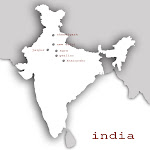




Leaving Chandigarh, we traveled southward to the small town of Patran. During our journey our driver left the car for a few moments to conduct some business at a street shop. While we were parked a young child, holding her presumably younger sister, approached our car. She constantly tapped on our windows begging for help. Once again my heart broke for these children. Whenever we would make eye contact with the little one she would give us the most adorable smile, which made it even harder to bear. It is truely incredible the amount of poverty there is in this country.
Once were arrived in Patran we visited with the Toor family and spent the night on their 30 acre farm. This family really opened their home to us and we felt very welcome. They had donated 3 acres of land adjacent to their property for the construction of a new "Nanaksar Academy". Eager to show off their school, they took us on a tour. The school is one year old with an addition that is still being constructed and you could tell it was the pride of the community. It was interesting to see the craftsmanship and quality. Compared to what we are used to it felt old and very used. Beyond the concrete and plaster was something deeper though. There was a sense of achievement and accomplishment - knowing that their children would have a place to study and learn. This building lent itself to a spirit of entrepreneurship and investment in the future of their children and their community. I will never know just how much that school means to them but I know it goes deeper than words can tell. Later in the day, about 20 minutes before sunset one of the Toor sons asked me to sketch the school for them. I quickly grabbed my pens and sketchbook and down the road we went. Finding a somewhat appropriate ledge I sat down and frantically sketched. The evening light was quickly fading and music filled the air from the local Hindu Temple; providing the perfect backdrop. Insects and mosquitos were coming out in the cool air. (Later, I discovered that I have received many bites to the arms and legs while trying to draw the school.) It felt good to sketch and to be forced to sketch so quickly, with anxious observers peering over my shoulders. At one time I even needed the assistance of a flashlight to complete the drawing. That drawing is now on display in the school for all of the children to see. It is amazing the power of such a little sketch. I guess i take my meager ability to sketch for granted most of the time. It is just a drawing right? To some it is much more!
Perhaps professing through sketching is much more than a self gratifying act. it requires a selfless act and a deeply truthful expression. By giving my sketch away, never to see it again perhaps, I find that it means more to me. All I have is a simple photograph, taken in poor light, to remind me of that moment when on a cool evening a sketch became much more than a sketch, it became an extension of the school and what that school means to its community.
After my sketching was done we traveled a short distance to visit the local Temple. I approached with a deep respect and reverence to such a place. Music and singing had been filling the air of the village since 3am and would continue until 9pm, only to start over again in the morning. We washed, removed our socks and shoes, covered our heads and entered. Approaching the focal point of the Temple we put our hands together and knelt before the Hindu God after which we received a sugar gift from the Temple worker. The Toor family visit this Temple every day in the morning and evening. It is part of their daily ritual and an integral part of their lives, in fact you could say that it is central. In addition, located at the highest point of their home is another worship space, allowing for worship at any time.





















































